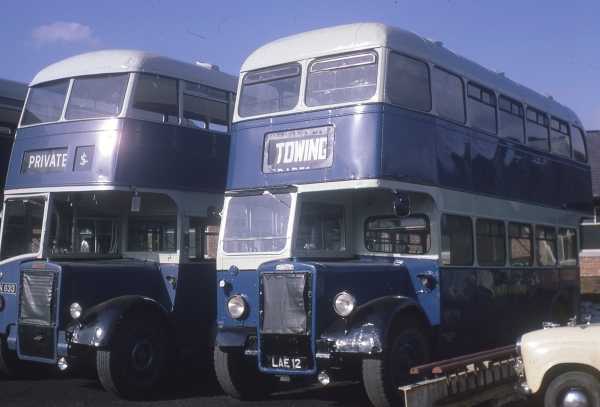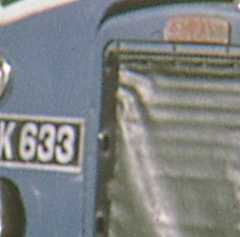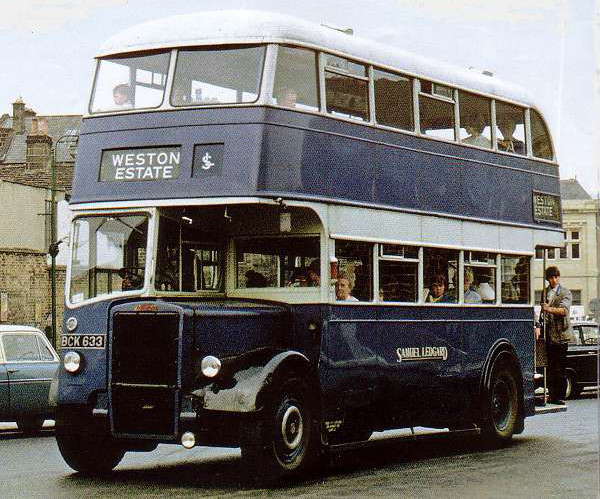Missing registration number
Missing registration number

I took the above shot some time during the 60s.

Can anyone fill in the rest of the registration number of the neighbouring Titan, which I failed to include in full?
Ian Thompson
02/10/11 - 15:20
On the assumption that the buses shown are those of Samuel Ledgard, the fleet list shown at this link indicates that it might be BCK 633, a Leyland PD1A, new to Preston Corporation in 1946, which is listed as having a Samlesbury H32/26R body. I have to say, however, that the bodywork in Ian's photo looks pure Leyland to me, so, perhaps, there is another answer.
Roger Cox
03/10/11 - 07:04
I believe that in the days when the Leyland Body Shop was really busy several bodies were built by outside bodybuilders among them Samlesbury and Alexander. I remember that Samlesbury rebuilt some trolleybus bodies for Bradford Corporation. Latterly the company built semi trailers.
Philip Carlton
03/10/11 - 07:05
This raises a very interesting matter! In the early post war period, pressure at Leyland led to the bodywork for some PD1's being contracted out, most commonly known to Alexander but also apparently to Samlesbury. Blackburn Corporation had some and now it seems Preston did as well. The Blackburn website referred to in the recent posting about the PS1 states that prior to April 1947, Samlesbury was known as Lancashire Aircraft Company. The bodies were pure Leyland in appearance, perhaps someone may know if there were any detail differences, Preston appeared to specify one piece drivers windscreens although these could have been altered by themselves. Some time ago, I wrote to Classic Bus asking if they would consider doing in-depth articles about Santus and Samlesbury, we got Santus, I hope that Samlesbury, a fascinating subject, will appear in a future edition. As for BCK 633, take your pick, Lancashire Aircraft bodywork or Samlesbury?
Chris Barker
03/10/11 - 07:07
In the 1965 edition of BBF6, Preston batch BCK 625-635 are shown as Leyland-bodied PD1s, although the batch was in course of withdrawal and BCK 633 is not listed.
See also http://www.sct61.org.uk/lgbck633.htm
Peter Williamson
03/10/11 - 07:12
In Mike Rhodes' book 'Preston's Trams and Buses' he says, about the 21 PD1As received in 1947, that 'whilst they were again fitted with Leyland style bodies, nos 95-100 (BCK 629-34) had been subcontracted out to nearby Samlesbury Engineering Ltd for assembly.'
Dave Williamson
03/10/11 - 07:13
I seem to recall reading that Samlesbury built some Leyland-design bodies, although can't think where that was to check! It would explain the apparent confusion.
David Beilby
03/10/11 - 11:50
The subject of the early postwar subcontracting of these bodies is a fascinating one, and the countless detail differences, interior and exterior, are a subject on their own. At Samuel Ledgard we had several vehicles in this category. The bus in the picture, BCK 633, was a Samlesbury example - I've driven and conducted it many a thousand happy miles and would just love to do some more. It was one of the very best individuals in a fine breed, and was powerful, quiet and smooth to an unbelievable degree - and the bodywork absolutely faultless even when approaching twenty years old. The Ledgard involvement in the Leyland body issue began early in August/September 1946 and lasted twenty one years. Of the batch of six brand new PD1s in 1946 JUM 373 was by Lancashire Aviation, while JUM 374-8 were "the real thing." In 1961 however, the seven PD1s we had from Preston Corporation were very assorted but every one a fine sound, likeable and spritely vehicle. ARN 392/3/4 all hailed from the Alexander stable, BCK 621/624/636 from Leyland, and just for a bit of variety BCK 633 from Samlesbury.
Chris Youhill
04/10/11 - 10:46
Many thanks, everyone, for the information on BCK 633. It was LAE 12 that took my eye, with "just another" Leyland-bodied Leyland beside it. But matters apparently weren't that simple! And 32 up top was still uncommon in 1946.
Two more questions, which internet searches so far haven't answered:
1) I know that Samlesbury made some coach bodies, but did they turn out any own-design bus bodies?
2) How d'you pronounce "Samlesbury"? I've heard it uttered as "Sahmsbury", the first syllable sounding like Psalms. I'd be interested to learn the definitive version from Lancastrians---or even in-the-know outsiders!
Ian Thompson
04/10/11 - 14:28
Glad to be of help Ian, and LAE 12 is another PD1 which meant the World to me - it was the first bus in which I carried fare paying passengers after passing my double deck test - the next day in fact. It was a mixture of delight at achieving my life's ambition and the sheer terror of facing the public thus for the first time. What's more I had to suffer nerves all day until 4.43pm in Burley in Wharfedale (relief point) - well 4.53 actually because it unavoidably arrived ten minutes late as the 4.00pm from Leeds King Street to Ilkley was a real bruiser. The journey went like a dream and the bus behaved beautifully to such an extent that by meal break time in Ilkley at 6.53pm the lost time had been fully recovered, and after refreshments the rest of the busy Friday evening was a cakewalk with little road traffic but plenty of passengers. Having reversed into Otley depot at 11.45pm I felt a real glow of happiness and satisfaction as I put the fuel hose in the tank and "filled her up" - I'd actually done my very first duty, a whole very busy late turn, without a hitch. The next day was the same duty but two hours longer with an extra round trip on Leeds - Guiseley - Ilkley and a complete contrast in machinery - my first ever encounter with the front seat of a Mark V synchromesh AEC Regent with 65 seats and enough power to reach the moon!! Sorry about the waffle - back to Leyland bodies. The Preston vehicles, and all other Leyland bodies with Ledgard were of course built with 56 seats, 30 upstairs. There was an enormous amount of excess space on the offside "up aloft" and Ledgard's themselves closed the gaps a little and installed an extra double seat there, hence the eventual H32/26R - but still plenty of circulating area at the top of the staircase.
Chris Youhill
04/10/11 - 20:47
Samlesbury certainly constructed its own style of bus bodywork, the famous example being the Green Bus of Rugeley 1948 Foden PVD6 SRE 881, with L27/26R body. See: http://www.sct61.org.uk/zzsre881.htm The firm also built other kinds of commercial bodywork for lorries and vans.
Roger Cox
05/10/11 - 06:40
There were two such Fodens new to Green Bus, SRE 881 and TRE 601 and another very similar body was supplied to Lancashire United in 1950, on a 1944 Guy Arab II which was rebodied after a serious accident, it was FTE 330. I remember also seeing a picture of a coach on a Daimler CVD6 chassis which ran for an operator in the Yorkshire Dales.
Chris Barker
05/10/11 - 14:21
The Samlesbury coach which I referred to was MTJ 843. It had a full front body and operated for E Sherriff, Reliance Motor Services of Sutton-on-the-Forest. Does anyone know it's origins?
Chris Barker
06/10/11 - 07:29
On the Classic Manx Buses website http://www.skylineaviation.co.uk/buses/+IOMRS.html 1947 PD1As GMN 775-781 are shown as having Lancashire Aircraft bodies, while GMN 782-3 and HMN 726-7 are shown as Samlesbury (sic).
Peter Williamson
12/10/11 - 06:32
Sorry if I'm a bit late with my comments, but I have only just discovered your page. Leyland contracted Alexanders to build 50 highbridge bodies on PD1 chassis due to pressure on its assembly line. A further contract for 16 was cancelled but diverted to Samlesbury Engineering. These stayed very local - ten for Blackburn and six for Preston. It would seem that Alexanders had their own 'proper' production line, which would have been uneconomic for Samlesbury. Their operation was probably more like a CKD relationship with Leyland.
Geoffrey Cunliffe
01/12/11 - 17:26
In response to Chris Barker's question, the Samlesbury bodied Daimler CVD6 coach was new to Platt, Bolton in 1951, and may previously have been a Samlesbury demonstrator (PSV Circle records). There is a photo of a 1950 full-fronted Samlesbury coach on Leyland PS1 chassis (JP 8144, Smith's of Wigan) in Eric Ogden's book, 'Shearings' (no 14 in the TPC 'British Bus ..... Systems).
Dave Williamson
09/05/12 - 20:00
I've just been flicking through my copy of "Bus Fleets of Portuguese Cities and Municipalities" (Ian Manning, DTS Publishing) and a photo caught my eye.
Knowing that Lisbon was a keen user of half-cab AEC Regent III's and V's from the early postwar period until the 1980s, with their amazing Weymann-styled left-hand drive "mirror-image" British appearance, I never knew until today that they bought any Leylands.
In 1947 Lisbon Tramways (then British owned) bought seven OPS1 chassis and fitted them with local B32D bodies but also, and this is where it becomes relevant to this thread, two PD1A's complete with "Lancashire Aircraft" H30/26R bodies.
In the book there is a photo of one of these and it could, if held to a mirror, be mistaken for a Preston or Ribble example. Did Lancashire Aircraft/Aviation/Salmesbury/Leyland hope to develop an export business for these? No doubt they would have hoped for a follow-on order from Lisbon because to make just two of these "mirror-image" buses can hardly have been economical for them.
I naturally decline to scan the book for this photo, so perhaps someone else has a shot of one that we can share on this site?
Paul Haywood
11/05/12 - 08:16
As you were!
My rushed comment that these PD1A's were "mirror-images" was only partly correct I'm afraid. Although the open rear platforms were on the right (UK offside) I stupidly failed to notice that the driver's cab is also offside (ie. UK right-hand drive)! This must have made life rather difficult for the drivers. Further reading reveals that these two buses undertook the first trials of double-deck operation in Lisbon and paved the way for large-scale use of (left-hand drive) AEC's.
Paul Haywood
14/10/12 - 10:57
Ian asks for the correct pronunciation of the word. In my youth, I used to listen to our radio, which was one of the first to have "VHF". Quite apart from the broadcasts of Radio Caroline when based off the Isle Of Man - the station is STILL going! - it used to be possible to listen to the Police radio. The association with Psalms is the correct version. In the area between Preston and Blackpool is another phonetic conundrum. It's written as Lea, but how do you say it? There's Leigh, of course, so you have to avoid confusion. LEA was spoken on the Police radio as LEAR, To many, Leigh still is in Lancashire, in the same way as many of the residents consider Christchurch still to be in Hampshire. They let Dorset "look after a few bits" to take the pressure of Hampshire!
Pete Davies
15/10/12 - 10:51
Many thanks, Pete Davies, for your definitive answer to my "Psalmsbury" question. Nothing worse than mispronouncing names of people and places. I've sometimes wondered how many Scots grind their teeth at the "Strawn" pronunciation of Strachan---though that's the only pronunciation I've ever heard for the bus-body builder. I'm in full agreement over the absurd 1974 meddling with county boundaries: I simply don't recognise the "changes".
Ian Thompson
15/10/12 - 17:14
Ian, I agree entirely. I live in Huntingdonshire, and refuse to accept its being swallowed whole by Cambridgeshire.
Like you, I always accepted "Psalmsbury" as the correct version. Despite the more logical pronunciation being customary in Scotland, the coachbuilder was always referred to as "Strawn", but this latter seems to arise from the Chipping Camden guide to preferred pronunciation, which includes "Chumley" (Cholmondeley), "Marnee" (Mahoney) and, of course "Mannerring" (Mainwaring). Back on the subject of buses
I hope to send in some pictures of Reading Corporation psvs and trolleys in the not too distant future.
Roger Cox
15/10/12 - 17:30
Ah, Ian, Strachan pronunciation is involved in the Pareto Principle! In the UK, 80% of folk pronounce it Strachan and 20% Strawn. In the US, Canada and Australasia, it's also universally Strawn. The Scottish village of Strachan is pronounced Strawn, however!
Good job there were no bodybuilders called Death, Featherstonehaugh, Dalziel, Cholmondeley, at least, not to my knowledge!
Chris Hebbron
16/10/12 - 05:10
Having both lived in Lancashire and supplied BAe Samlesbury into which Samlesbury Engineering was absorbed I can confirm the "Psalmsberry" pronunciation. As an interesting sidelight one or two of the BBC's migrants from London to Salford have been caught out by the town of Bury, pronouncing it "Burry" instead of "Berry".
Samlesbury have built buses, coaches, (see this link) vans and trailers to their own and the designs of others as well as rebuilding buses with a mix of original and their own parts.
Their most (in)famous product was Donald Campbell's boat Bluebird in which he was killed.
In 1960 Samlesbury also bought out Edgar Percival's aircraft building company and manufactured the not too successful EP9 Prospector under the name The Lancashire Aircraft Company - not to be confused, as it often is, with the Lancashire Aircraft Corporation which had been bought out by British Aviation Services in 1955 from the owner of Samlesbury Engineering.
The bus building was in response to demand in the immediate post WW2 period but as demand dwindled, manufacturing turned to vans and trailers.
As far as I know the Lancashire Aircraft Corporation side of the business didn't build any buses and the Lancashire Aircraft Company certainly didn't.
Phil Blinkhorn
17/11/12 - 13:19
How very strange! In a comment I made to this subject in October last year, I said that I'd written to Classic Bus to ask if there would be any possibility of articles about Santus and Samlesbury. Well, after almost three years, I sent my letter in Feb. 2010, it's just been printed in the latest edition! My hope has been restored that we may yet see an article about the very interesting firm, Samlesbury Engineering!
Chris Barker
16/04/17 - 07:48
Further to Chris Barker (05/10/11: 0640) here's a shot of the former LUT FTE 330, after use by a subsequent operator. https://thetransportlibrary.co.uk
David Call
17/04/17 - 08:10

Here is a nice picture (source unknown) of BCK 633 looking immaculate as usual and having a breather from the long trunk routes. Its just arriving in Otley Bus Station after one of many trip per day to Weston Estate. This was a very busy route indeed but easy for timekeeping - ten minutes out, ten minutes back, and ten minutes in the bus station. The young conductor is no doubt "playing to the house" with the dodgy
Chris Youhill
17/04/17 - 08:10
David C, thanks for that photograph link, I know of only three of these Samlesbury bodies which I understand were called 'Lo-hite' There were the two Fodens for Green Bus of Rugeley, SRE 881 and TRE 601 and this LUT Guy which was a re-body on a wartime chassis. Perhaps Samlesbury were hoping their new and quite nice four bay design would attract rather more orders but it wasn't to be.
Chris Barker
Comments regarding the above are more than welcome please get in touch via the 'Contact Page' or by email at obp-admin@nwframpton.com
All rights to the design and layout of this website are reserved
Old Bus Photos from Saturday 25th April 2009 to Wednesday 3rd January 2024